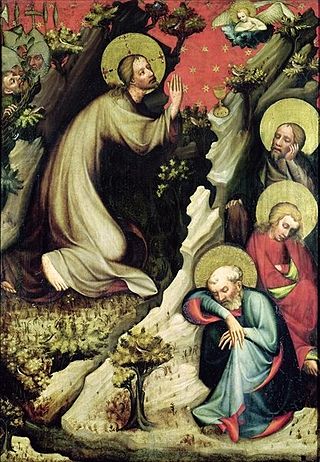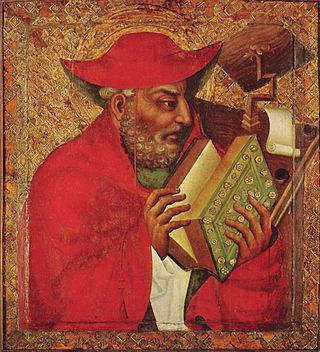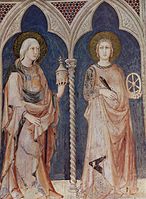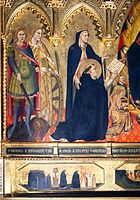
Master Theodoric, in Latin Magister Theodoricus was a Bohemian painter. He is the best documented Bohemian Gothic painter. He was the favourite court painter of Charles IV, Holy Roman Emperor. and the first Bohemian painter whose name can be linked to a body of work. Theodoric is considered the chief representative of the phase of International Gothic known as "the Soft style". His masterpiece is the Chapel of the Holy Cross at Charles' newly completed Karlštejn Castle, near Prague, containing a large series of slightly over-lifesize half-length panel portraits of saints and other notable figures on a gold ground. The whole decoration of the chapel was commissioned in 1359 and completed over a number of years. The decoration of the Chapel of the Holy Cross was unique and unprecedented at the north of the Alps. Theodoric's oeuvre is not comparable to anything in European art after the mid-14th century (1360th).

The Zbraslav Madonna comes from the parish church of St James the Greater in Zbraslav. It is on long-term loan at the permanent exhibition of the National Gallery in Prague.

The Třeboň Altarpiece, also known as Wittingau altarpiece, is one of the most important works of European Gothic panel painting. Of the original large altarpiece retable created in about 1380 by an anonymous Gothic painter called the Master of the Třeboň Altarpiece, three wings, painted on both sides, have survived. The altarpiece is one of the works that helped towards the emergence of the International Gothic style and which influenced the development of art in a broad European context.

Lamentation of Christ from Žebrák is a lime wood relief of the common subject of the Lamentation of Christ, from about 1510. It ranks among the finest works of Late Gothic sculpture in Bohemia. The anonymous artist, who is called the "Master of the Žebrák Lamentation of Christ" after this work, probably had his workshop in České Budějovice and could have been the same person as the woodcarver Alexandr who was in charge of that town's guild between 1503 and 1516. The relief is now part of the permanent collection of medieval art at the National Gallery in Prague.

The Strakonice Madonna is a Gothic wooden sculpture of the Madonna and Child of about 1300-1330. It comes from the Johannite Commandry in Strakonice that was founded in 1243. It is a rare surviving early Gothic sculpture that is directly related to French or Rhineland cathedral sculpture of the 13th century. It is exhibited in the permanent collection of medieval art at the National Gallery in Prague.

The St Catherine Altarpiece is a set of panel paintings from the period around 1515 that is ascribed to the workshop of the Master of the Litoměřice Altarpiece. A total of six panel paintings survive from the original retable: one wing painted on both sides and two panels painted on one side in the collection of the National Gallery in Prague and two panels in the private collection of G. Schäfer (Schweinfurt).

Madonna of Žebrák is a fully sculpted Gothic wooden statue, the work of an anonymous carver known as the Master of the Madonna of Žebrák, who worked at the same time as the Master of the Třeboň Altarpiece and was close to him in his artistic style. The sculpture occupies an exceptionally important place in the development of Czech sculpture of the late 14th century and forms a wooden counterpart to the beautiful Madonnas carved in marlstone. As a loan from the parish church of St. Lawrence in Žebrák, it is on display in the exposition of medieval art of the National Gallery in Prague.

Saint Luke the Evangelist is one of the most impressive panel paintings by Master Theodoric, intended for the decoration of the Chapel of the Holy Cross in Karlštejn. It may be a self-portrait of Theodoric himself. It is exhibited in the collection of medieval art of the National Gallery in Prague.

Saint Matthew the Evangelist is an oil tempera on beech board painting by Bohemian painter Master Theodoric. It forms an almost symmetrical counterpart to the image of Saint Luke on the altar wall in the Chapel of the Holy Cross. It is an exceptionally high quality painting by Master Theodoric. The painting is exhibited in the collection of medieval art of the National Gallery in Prague.

Saint Jerome is one of the finest paintings by Master Theodoric in the Chapel of the Holy Cross at Karlštejn. He has an honourable place in the hierarchy of the Holy Fathers and his portrait is placed in the south window niche of the chapel together with St. Augustine, St. Ambrose and St. Gregory. It is one of the oldest and most frequently reproduced depictions of St. Jerome. The painting is exhibited in the collection of medieval art of the National Gallery in Prague.

Saint Maurice is an oil tempera on beech board painting by Bohemian painter Master Theodoric, created around 1360-1365. It is probably the first depiction of a black man in Czech painting. The extraordinary importance of this knight in the conception of the Chapel of the Holy Cross is evidenced by the portrait's placement in the main space of the presbytery adjacent to the painting of St. George and the Bohemian patron saint St. Vitus.

Saint Simon is an oil tempera on beech board painting attributed to Master Theodoric, created around 1360-1365. In the Chapel of the Holy Cross at Karlštejn, his image is placed on the eastern (epistle) wall of the presbytery behind a dividing metal grille.

St. Charles the Great (Charlemagne) is an oil tempera on beech board painjting by Bohemian painter Master Theodoric. It is included in the set made for the Chapel of the Holy Cross at Karlštejn by the artist himself. The portrait was placed in a prominent position in the middle of the row of rulers on the west wall of the nave. The quality of the artwork ranks it among the finest works of 14th century European painting. The painting is on display in the collection of medieval art of the National Gallery in Prague.

St George's Altar is a large Gothic altarpiece from the 1460s-70s, originally placed in the St George's Convent at Prague Castle. It belongs to the property of the Metropolitan Chapter of St. Vitus and is on loan to the exhibition of medieval art of the National Gallery in Prague.

Crucifixion from Nové Sady, is part of a larger altar polyptych called the Rajhrad Altarpiece. Its author is the last important personality of Czech panel painting of the pre-Hussite period, known as the Master of the Rajhrad Altarpiece. The painting is on display in the permanent exhibition of the National Gallery in Prague.

The Velhartice Ark, dating from 1490 to 1500, is almost the only completely preserved late Gothic altar of its kind in the Czech lands. The altar is exceptional in the quality of its carving. It was originally commissioned for the parish church of the Nativity of the Virgin Mary in Velhartice in south-west Bohemia, where it probably stood on the mensa of the main altar. It is on display in the exposition of medieval art of the National Gallery in Prague.

The Crucified Christ from the Augustinian monastery church of Saint Giles in Třeboň is one of the most important sculptural monuments from the end of the reign of Charles IV. It was part of a set of sculptures attributed to the Prague workshop of the Master of the Madonna of Žebrák. The statue of the Crucified Christ is on display in the permanent exhibition of the Aleš South Bohemian Gallery in Hluboká nad Vltavou.

The Franciscan Madonna is a monumental carving of the late beautiful style, which is compositionally related to the Pilsen Madonna. In some details, it resembles works from the circle of the Master of Týn Calvary. The statue comes from the main altar of the Church of the Assumption of the Virgin Mary of the Franciscan Monastery in Pilsen and is on display in the exposition of medieval art of the National Gallery in Prague.

Puchner's Ark is a Gothic retable commissioned in 1482 by Nikolaus Puchner, Grand Master of the Knights of the Cross with the Red Star, for the church of St. Francis of Assisi in Prague's Old Town. The anonymous author of the panel paintings is referred to as the Master of the Puchner Altar. Part of the altar is on display in the National Gallery in Prague.
Master of the Luxembourg Genealogy was the court painter of the Holy Roman Emperor Charles IV. He is referred to by his most important work, the murals with figures of the monarchs in the imperial palace at Karlštejn Castle.























